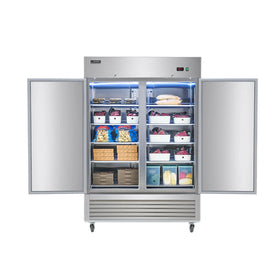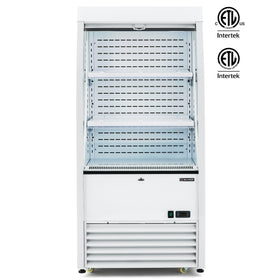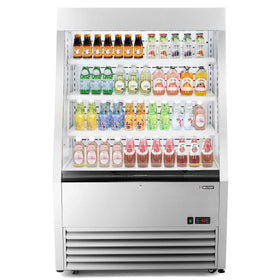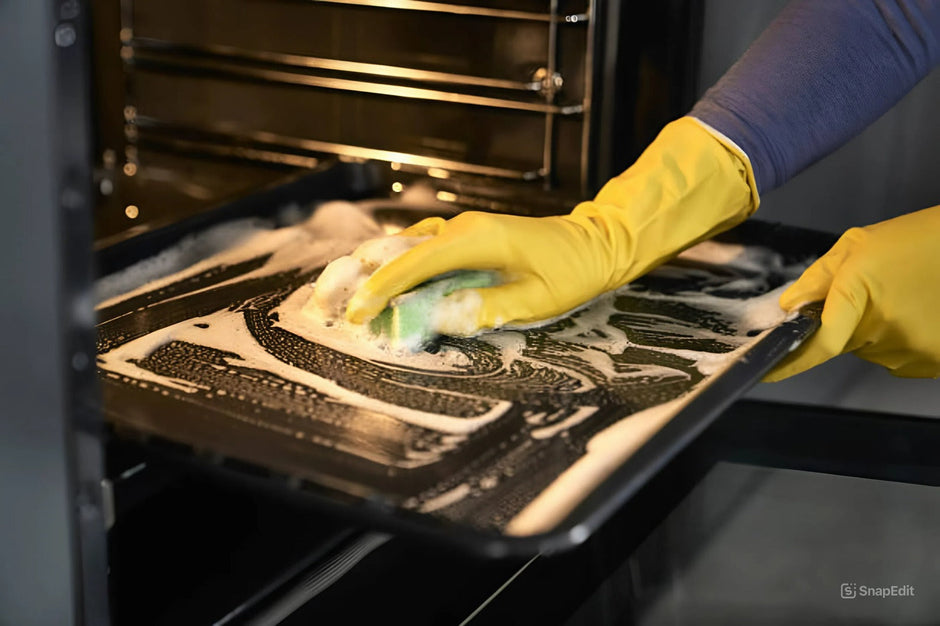When we talk about cooling down in the context of refrigerators, we are referring to reaching a temperature below 40°F (4°C). The faster your fridge cools to below 40°F (4°C), the better it preserves the food items in it and prevents them from spoiling.
Understanding the cooling time of refrigerators is essential, whether you’re buying a standard refrigerator for home use, a commercial refrigerator for a commercial kitchen, or a display refrigerator for retail establishments.

What to Know About Refrigerator Cooling Time
- On average, a full-sized household fridge takes about 4-12 hours to reach a safe cooling temperature after being plugged in.
- However, the time it takes a refrigerator to cool generally depends on its size and internal volume, the quality of its ventilation and airflow system, and the strength of its compressor.
- Another very important factor that determines refrigerator cooling time is the age of the refrigerator.
- The newer a refrigerator is, the longer it takes for it to reach cooling temperatures.
- A brand-new fridge may take up to 12 hours or more to reach the target cooling temperature, depending on the size and type.
Refrigerator Cooling Times For Different Kinds of Refrigerators
Here is a table showing how long you can expect different types of refrigerators to cool, whether they are brand new or just being plugged in after being initially unplugged.
| Fridge Type | Average Cooling Time | Cooling Times for New Refrigerators | Cooling Times for Used Refrigerators (After Being Unplugged) |
| Full-size household fridge | 4–12 hours | 8–12 hours | 4–8 hours |
| Mini-fridge | 2–4 hours | 4–6 hours | 2–4 hours |
| Commercial reach-in refrigerator | 1–5 hours | 4–8 hours | 2–5 hours |
| Display fridge (open-air cooler) | 30 minutes–4 hours | 2–6 hours | 1-4 hours |
| Chest freezer | 6–12 hours | 8–12 hours | 6-10 hours |
| Undercounter Refrigerator | 6–10 hours | 3–6 hours |

1. Mini Fridge Cooling Time
On average, a mini fridge can cool down in just 2-4 hours because it is compact and has a lower internal volume. Being the smallest type of refrigerators, mini-fridges take the shortest amount of time to cool.
- A brand new mini-fridge, however, takes longer to cool, usually about 4-6 hours.
- After being unplugged, a used mini fridge might take just about 4-8 hours to cool.
2. Household Refrigerator Cooling Time
The average household refrigerator takes about 6-12 hours to cool fully because they are larger and typically have less formidable cooling systems.
- Brand-new household refrigerators take longer to cool: usually about 8-12 hours.
- A household refrigerator that is being plugged back in would take just about 4-8 hours to cool.
3. Commercial Refrigerator Cooling Time
Commercial refrigerators are designed for optimal performance, and therefore, they typically take 1-5 hours to cool.
- On average, a brand-new commercial refrigerator would take longer to cool: about 4-8 hours.
- A used commercial refrigerator that might take about 2-5 hours to cool.
Why Do Commercial Refrigerators Cool Faster?
Given that commercial refrigerators have large surfaces, sometimes up to 60 cubic ft., 1-5 hours is a reasonably fast cooling time. They are able to cool faster because:
- They are equipped with strong fans that help distribute the cold air faster
- They often have high-efficiency compressors, which help them cool more effectively.
- They have stainless steel interiors, which are better at conducting heat.
4. Display Fridges Cooling Time
Commercial display fridges are designed for quick chilling, and they often feature powerful evaporator coils and directed airflow, which allows them to cool within 30 minutes to 4 hours.
A new open-air display fridge may take about 2-6 hours to cool, while a unit that is plugged in after initial use takes about 1-4 hours.
5. Chest Freezers Cooling Time
Chest freezers take the longest time to cool (6-12 hours) because of their horizontal layout, and also because they have a deep internal space, which takes more time to reach.
Why Do New Fridges Cool Faster?
New fridges generally take longer initially to cool. On average, a new fridge of any kind takes about an hour or two longer to cool than a used fridge. There are three main reasons to explain why:
- A new fridge starts at room temperature, which means every component (insulation, walls, shelves, and compartments) is warm.
- The compressor and cooling system have not been cycled yet, so it initially takes time for the refrigerant to cycle and stabilize efficiently.
- Some modern fridges don't start up immediately: they are designed to run through brief calibration cycles before full cooling begins

Want a Fast-Cooling Commercial Refrigerator? Here’s What to Look For
The most significant advantage of using a commercial refrigerator that cools quickly is that it helps reduce downtime and speed up product placement, food preparation, and customer service.
In addition, commercial refrigerators that cool quickly help ensure food safety standards are met and contribute to energy efficiency, which is crucial in a commercial kitchen.
Here are the main factors to look for when looking for a commercial refrigerator that cools fast
- Look for a high-performance compressor. The compressor power is often listed in BTU or HP. The higher the compressor power, the faster the cooling.
- Look for fan-assisted air cooling. Fan-assisted cooling (or frost-free systems) ensures fast and even temperature distribution.
- A stainless steel interior. Stainless steel conducts and holds cold more efficiently than plastic, helping cool contents faster.
- Proper insulation. Energy Star ratings and manufacturer details can help determine the quality of insulation.
Top 3 Fast-Cooling Commercial Refrigerators For Your Commercial Kitchen
1. Wilprep 27" Commercial Solid Door Reach-In Freezer
Wilprep's 27" single door commercial fridge offers a volume of 18.7 cu. ft. and a temperature range of 32-50°F, letting you properly store meat, seafood, desserts, and more frozen foods for your business.
- Compressor: Cubigel compressor+ copper evaporator
- Interior: Stainless steel
- Insulation level: meets the applicable requirements of Energy Star and CEC. Certified by.ETL, ETL Sanitation, and DOE.
2. 54'' Commercial Solid Door Reach-In Refrigerator
Wilprep's 54" double door commercial refrigerator offers a volume of 42.2 cu. ft. and a temperature range of 32–50°F. You can customize your storage using the 10 adjustable shelves, with each capable of holding up to 88 lb.
- Cooling system: Embraco compressor and copper evaporator, auto defrost design
- Interior: Top quality stainless steel
- Insulation level: meets applicable requirements of Energy Star and CEC. Certified for safety and quality by ETL, ETL Sanitation, and DOE
3. 81'' Commercial Solid Door Reach-In Refrigerator
Wilprep's 81" triple door commercial refrigerator offers a volume of 9 cu. ft. and a temperature range of 32-50°F. You can customize your storage using the 15 adjustable shelves, with each capable of holding up to 88 lb.
- Cooling system: Cubigel compressor + copper evaporator, auto defrost function
- Interior: Stainless steel
- Insulation level: meets applicable requirements of Energy Star and CEC.Certified by ETL, ETL Sanitation, and DOE
What Affects Refrigerator Cooling Time?
i. The Size and Internal Volume of the Fridge
Generally speaking, the larger the fridge is, the longer it takes to cool. Bigger fridges have more surface area that needs to be chilled, and so it takes longer for the cool air to circulate.
A mini-fridge with 1.7 cubic feet will naturally cool faster than a 25-cubic-foot French door unit.
ii. Ventilation and Airflow System
If your fridge has forced air cooling (a fan-assisted system), it will cool more quickly. The serrated blades of a fan-assisted cooling system help distribute cold air more efficiently and evenly throughout the interior of the fridge.
iii. The Strength of the Compressor
Commercial refrigerators are able to cool down in just about 1-5 hours because they use more powerful compressors. Powerful compressors cycle refrigerant faster and are better equipped to handle rapid pull-down from room temperature.
iv. The Ambient Temperature
The temperature of the room affects how quickly the fridge cools. A fridge in a hot kitchen or warehouse will take longer to reach its set point than one in a cool, air-conditioned space.
v. The Initial Load of Items in the Refrigerator
An empty fridge will always cool down faster than a fridge that is loaded, especially if it is loaded with warm food or drinks. The presence of warm stuff in your fridge will slow down to cooling speed, and cause it to reach your desired temperature in more time than if it were empty.
vi. The Quality of Insulation
The better insulated your fridge is, the faster it will take for it to cool down. Thicker, high-quality insulation traps cold air better and stabilizes temperature faster. Poor insulation means more heat infiltration and longer cooling times.
Final Thoughts
Whether you’re setting up a new kitchen or managing a busy café, knowing how and why refrigerators cool the way they do helps you make better purchasing decisions and avoid unnecessary delays.
By focusing on key performance features—such as compressor strength, airflow system, and insulation—you can find a fridge that meets your cooling needs and keeps your products safe and fresh.










